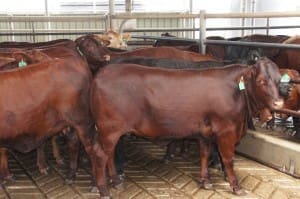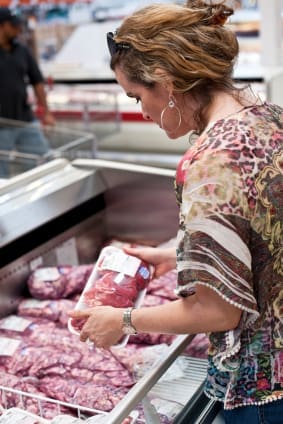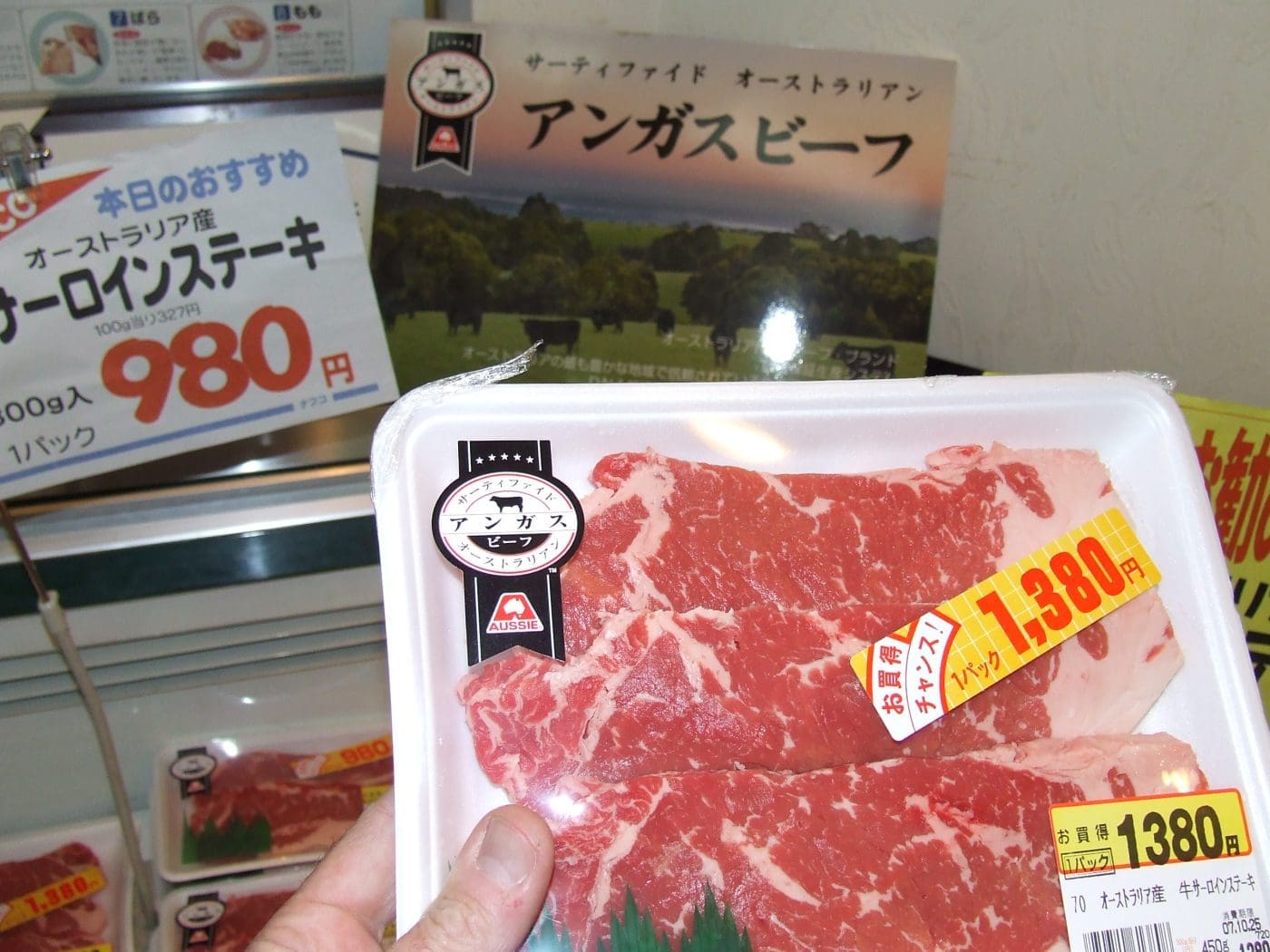- Drought underpins record beef offal exports
- Heifers lag 33¢ behind steers – how much can they move?
- Potential co-product values ease in June
- Thursday daily cattle summary
- Cattle market alert
- US meat stocks still well below last year
- Beef sales brisk in Japan, but concerns for strong prices
- Australia’s market share increases to 54pc in Korea
Drought underpins record beef offal exports
22 July 2014
Australian beef offal exports for the 2013-14 financial year reached a record volume, at 153,500 tonnes, underpinned by the drought fuelled surge in adult cattle slaughter over the course of the year. Korea became the largest market, with shipments for the year up 16pc, at 27,300t, overtaking Japan, where exports were 25,200t, up 2pc year-on-year. Hong Kong rounded out the top three markets for 2013-14, with 23,400t, which, despite being up 9pc year-on-year, wasn’t enough to gain the mantle as the largest beef offal market. It is likely that the almost doubling in volume to China, at 6200t, combined with increased (+403pc) volumes to Indonesia, at 12,400t, pulled product from Hong Kong. Volumes to the Middle East (6000t) and Malaysia (5,800t) also contributed to the greater beef offal exports for the year, with demand up 91pc and 29pc year-on-year, respectively.
In terms of cuts, tripe (36,600t) accounted for the largest volume, while liver shipments rose slightly for the year (3pc), led by a more-than-doubling in exports to South Africa, at 10,000t. Following was skirt (14,700t), with volumes up 10pc year-on-year, with approximately half the volume going to Japan and Korea, down 11pc and up 70pc year-on-year, respectively.
Heifers lag 33¢ behind steers – how much can they move?
22 July 2014
 Yearling steer and heifer prices traditionally track each other fairly closely, experiencing the same restocker and rain-enhanced peaks, and consequently, the same drought induced troughs. Interestingly, however, while steers and heifers follow the same trend, similar conditioned steers are always at premium to heifers, yet by how much varies considerably each season. During the start of the big herd rebuilding phase in 2010, the average premium for EYCI-eligible yearling steers was 14.5¢/kg, which includes dipping to as low as 7¢ in December 2010. Moving into 2011, where herd rebuilding became a strong focus for producers across the majority of the country, yearling heifer prices averaged just 12¢ behind the equivalent steer category, as the momentum at the end of 2010 carried through to 2011. However, as the dry conditions kicked in during 2012 for many regions across the eastern states, and in particular, the key cattle supply regions, the average heifer price for the year drifted to an 18¢/kg discount to steers. The difference peaked at 24¢ in December, when steers finished 2012 at 335¢/kg, while heifers were 311¢/kg.
Yearling steer and heifer prices traditionally track each other fairly closely, experiencing the same restocker and rain-enhanced peaks, and consequently, the same drought induced troughs. Interestingly, however, while steers and heifers follow the same trend, similar conditioned steers are always at premium to heifers, yet by how much varies considerably each season. During the start of the big herd rebuilding phase in 2010, the average premium for EYCI-eligible yearling steers was 14.5¢/kg, which includes dipping to as low as 7¢ in December 2010. Moving into 2011, where herd rebuilding became a strong focus for producers across the majority of the country, yearling heifer prices averaged just 12¢ behind the equivalent steer category, as the momentum at the end of 2010 carried through to 2011. However, as the dry conditions kicked in during 2012 for many regions across the eastern states, and in particular, the key cattle supply regions, the average heifer price for the year drifted to an 18¢/kg discount to steers. The difference peaked at 24¢ in December, when steers finished 2012 at 335¢/kg, while heifers were 311¢/kg.
The drought maintained its force for the duration of 2013, limiting the capacity for many producers to retain future breeding stock, and EYCI eligible heifers during the year ranged from a 20¢ to 35¢ discount to steers. Heifers during December 2013 averaged 295¢/kg, while steers were 330¢/kg. The drought pressure has remained for many regions during 2014, especially in northern NSW and western Qld, underpinning the ongoing reduced interest in young females. For the first seven months of 2014, EYCI-eligible heifers have traded at an average 33¢/kg discount to steers, with the July average for steers at 351¢/kg and heifers at 316¢/kg.
During good seasons, and when prices are trending up, the difference between steers and heifers becomes very tight, while in poor seasons, and the price trend is down, heifers fall further than steers and the relationship loosens. With this in mind, while the current average 33¢ price discount is significant, it implies that once seasonal conditions improve, and restocker demand is reignited, there is considerable room for heifer prices to move.
Potential co-product values ease in June
22 July 2014
In June, the potential co-product value for a heavy steer (average carcase weight 331kg) declined 8pc on the previous month and was 7pc lower than the corresponding period last year, at $215.10/head, with varied price trends experienced across most categories (Kurrajong Meat Technology – June 2014 co-products monitor). June saw the potential value of tallow reduce 24pc on both the previous month and on last year, to $46.77/head, mostly due to a maintenance shutdown from a major tallow producing company. Reports suggest that the meantime will see traders re-establishing markets in China, Taiwan and Pakistan, where tallow is priced relative to palm stearine. During June, the potential value of beef offal for a heavy steer was subdued (down 3pc) on the previous month and lower (4pc) than June 2013, at $60.40/head, underpinned by cheaper prices across some beef offal categories. Rumen pillars 500-700g declined 52pc on last year, at $6.09/kg, while tongue prices were 19pc lower year-on-year, to average $8.48/kg in June. Additionally, diaphragm membrane prices decreased 15pc on last year, to $3.22/kg, while beef kidneys averaged $0.81/kg for the month – back 8pc over the same period.
In contrast, the price of beef Meat and Bone Meal (MBM 50) in June was 5pc dearer than the same time in 2013, averaging $35.93/kg.
Thursday daily cattle summary
24 July 2014
Numbers decreased to 4385 head at Dalby sale, and there was extra processor support. Lightweight D2 yearling steers to restockers eased 6¢ to 148¢, while light weight yearling heifers gained 5¢ to 140¢/kg. Mediumweight grown steers to feeder buyers averaged 160¢, while medium weight D3 cows to slaughter lifted 4¢ to 115¢/kg. Heavy weight D4 cows to slaughter were unchanged in price to settle on 135¢/kg.
Consignments dropped slightly at Singleton to 740 head, and the majority of the yarding consisted of vealer steers and heifers. Light weight C2 vealer steers to restockers gained 7¢ to 163¢, while light weight D2 vealer heifers to restockers increased 41¢ to 135¢/kg. Heavy weight grown steers to slaughter lifted 5¢ to 140¢, while medium weight D2 cows to slaughter increased 14¢ to average 114¢/kg.
Yardings lifted to 947 head at Warrnambool, however quality varied throughout the young cattle section. Vealer heifers improved 12¢ to 145¢, while heavy weight yearling steers to slaughter topped at 207¢/kg. Heavy weight yearling heifers to slaughter settled on 194¢/kg. Heavy weight C3 grown steers to slaughter lifted 9¢ to 201¢, while bullocks to slaughter gained 16¢ and averaged 197¢/kg.
Cattle market alert
23 July 2014
Numbers ease marginally
Total national cattle supply was 7pc lower than the same period last week, at 32,148 head. Consignments across Queensland lifted 4pc week-on-week, to 10,713 head, with Roma store yarding nearly 8000 head, while numbers in NSW slipped 16pc, to 12,928 head. There were 13pc fewer cattle yarded across Victoria this week, at 5669 head, while cattle supply in SA eased only marginally, back 3pc to 1183 head. In WA, Muchea consigned 1514 head, lifting 36pc, while total throughput in Tasmania stood at 141 head. A number of markets reported improved numbers of well finished young cattle, supplementary fed and off winter oat crops, with these selling to very keen trade demand at Wagga. The absence of two major export processors at the Toowoomba sales saw bulls and cows sell cheaper and grown steers and heifers struggle to maintain firm prices. Extra restocker buyers attended the Roma Store sale, assisting light weight yearling steer prices, while feeder buyers were more selective in their purchases of the heavy weights. In Victoria, the overall quality of the cattle was plainer as a result of cold conditions, with increased numbers of veal lacking finish penned at Wodonga, although at Pakenham processors were undeterred and pushed prices higher for the better lines, along with some secondary categories.
US meat stocks still well below last year
23 July 2014
 Inventories of beef, pork and poultry in cold storage in the US are still dropping, according to the US Department of Agriculture’s Cold Storage report – showing the effects of ongoing low production and strong demand, despite relatively high prices of all meat proteins. The biggest drop in available supplies is in beef, with frozen stocks in warehouses down 26pc on the same time last year as at the end of June. It also increased the gap between this year’s storage and the five-year average, which has been growing from month to month. There was 145,000 tonnes in cold storage at the end of June, compared with 197,000t a year ago.
Inventories of beef, pork and poultry in cold storage in the US are still dropping, according to the US Department of Agriculture’s Cold Storage report – showing the effects of ongoing low production and strong demand, despite relatively high prices of all meat proteins. The biggest drop in available supplies is in beef, with frozen stocks in warehouses down 26pc on the same time last year as at the end of June. It also increased the gap between this year’s storage and the five-year average, which has been growing from month to month. There was 145,000 tonnes in cold storage at the end of June, compared with 197,000t a year ago.
Pork stores have also dropped, but by a much smaller amount – down 5pc on last year, to 244,000t. Chicken supplies were 18pc lower than a year ago, at 253,000t, and turkey supplies were down 19pc, to 209,000t – suggesting production will need to increase significantly in the next few months to meet seasonal Thanksgiving Day demand. The only meat to increase in storage compared with last year was lamb and mutton, which was 61pc higher, on 18,000t, coming off a very low base last year.
All of the declines in product availability point to dearer prices, or at least maintaining current highs, in US meat markets.
Beef sales brisk in Japan, but concerns for strong prices
23 July 2014
Japanese retailers reported good demand for beef and other livestock products in June, while the wholesale market registered rising imported beef prices.
Meat and meat product sales in June were up 8.8pc year-on-year, contributing to strong overall food sales during the month, according to the Japan Supermarket Association. Many outlets featured steak, yakiniku (Japanese/Korean style barbecue) and sushi packs during Father’s Day, resulting in increased demand. Japan Chain Stores Associations also reported improved performance of livestock product sales, with beef being one of fast-moving items. While brisk demand is welcoming news for the trade, there are concerns over rising imported beef prices, and whether consumers will continue to pay when businesses have to pass on the increase. Trade paper Chikusan Nippo reported on ongoing interest from the US for Australian high lean manufacturing products, and anticipation for further price strengthening of cow meat and full brisket for Japan.
Australia’s market share increases to 54pc in Korea
22 July 2014
 Korean beef imports during the first half of 2014 totalled 138,118t – 8pc and 10pc above 2013 and the five-year average, respectively. Chilled beef imports during the first six months were up 8pc on the corresponding period last year, at 20,900t, accounting for 15pc of total imports. The volumes of frozen beef also rose 9pc year-on-year, at 117,000t. Australia remained the largest supplier to Korea during the first half of 2014, at 74,700t, up 10pc year-on-year), with its market share up 1pc year-on-year, to 54pc. Chilled beef imports from Australia were the second highest volume on record, at 15,900t, while Australia supplied half of the total frozen beef during the first half of the year, at 59,000t – just 6pc below the highest volumes on record in 2007. Imports from the US during the first half of the year were up 15pc year-on-year, totalling 50,500t. With the larger quantity imported from the US into Korea, the US’s market share rose 3pc year-on-year, to 37pc. However, the volumes were still 53pc below the pre-BSE level in 2003.
Korean beef imports during the first half of 2014 totalled 138,118t – 8pc and 10pc above 2013 and the five-year average, respectively. Chilled beef imports during the first six months were up 8pc on the corresponding period last year, at 20,900t, accounting for 15pc of total imports. The volumes of frozen beef also rose 9pc year-on-year, at 117,000t. Australia remained the largest supplier to Korea during the first half of 2014, at 74,700t, up 10pc year-on-year), with its market share up 1pc year-on-year, to 54pc. Chilled beef imports from Australia were the second highest volume on record, at 15,900t, while Australia supplied half of the total frozen beef during the first half of the year, at 59,000t – just 6pc below the highest volumes on record in 2007. Imports from the US during the first half of the year were up 15pc year-on-year, totalling 50,500t. With the larger quantity imported from the US into Korea, the US’s market share rose 3pc year-on-year, to 37pc. However, the volumes were still 53pc below the pre-BSE level in 2003.



HAVE YOUR SAY